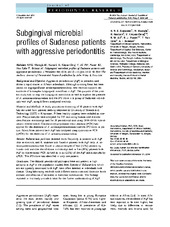| dc.contributor.author | Elabdeen, Hager Z.R. | en_US |
| dc.contributor.author | Mustafa, Manal | en_US |
| dc.contributor.author | Hasturk, Hatice | en_US |
| dc.contributor.author | Klepac-Ceraj, Vanja | en_US |
| dc.contributor.author | Ali, Raouf W. | en_US |
| dc.contributor.author | Paster, Bruce J. | en_US |
| dc.contributor.author | van Dyke, Thomas | en_US |
| dc.contributor.author | Bolstad, Anne Isine | en_US |
| dc.date.accessioned | 2015-03-27T10:36:48Z | |
| dc.date.available | 2015-03-27T10:36:48Z | |
| dc.date.issued | 2014-12-09 | eng |
| dc.identifier.issn | 0022-3484 | |
| dc.identifier.uri | https://hdl.handle.net/1956/9683 | |
| dc.description.abstract | Background and Objective: Aggressive periodontitis (AgP) is prevalent and shows a rapid course in African individuals. Although a strong focus has been placed on Aggregatibacter actinomycetemcomitans, new methods support the existence of a complex subgingival microflora in AgP. The purpose of the present study was to map the subgingival microbiota as well as explore the presence of A. actinomycetemcomitans and the JP2 clone in a group of Sudanese individuals with AgP, using different analytical methods. Material and Methods: A study population consisting of 19 patients with AgP was recruited from patients seeking treatment at University of Science and Technology (UST) in Khartoum. Fifteen healthy subjects were included as controls. Plaque samples were analyzed for 272 taxa using human oral microbe identification microarrays and for 26 periodontal taxa using DNA-DNA hybridization checkerboard. Conventional polymerase chain reaction (PCR) was applied for the detection of A. actinomycetemcomitans and the JP2 clone in plaque. Saliva from patients with AgP was analyzed using quantitative PCR (qPCR) for the detection of A. actinomycetemcomitans. Results: Eubacterium yurii was detected more frequently in patients with AgP than in controls, and E. nodatum was found in patients with AgP only. A. actinomycetemcomitans was found in plaque samples of two (12%) patients by human oral microbe identification microarrays and in five (29%) patients with AgP by conventional PCR, as well as in six (32%) of the AgP saliva samples by qPCR. The JP2 clone was identified in only one patient. Conclusion: The classical periodontal pathogens were not present in high amounts in AgP in the population studied here. Species of Eubacterium, which are not typically associated with AgP, were often detected in individuals with disease. Using laboratory methods with different sensitivities and detection levels allowed identification of variances in microbial communities. The findings reported in this study provide a basis for the further understanding of AgP. | en_US |
| dc.language.iso | eng | eng |
| dc.publisher | Wiley | eng |
| dc.rights | Attribution-NonCommercial-NoDerivs CC BY-NC-ND | eng |
| dc.rights.uri | http://creativecommons.org/licenses/by-nc-nd/4.0/ | eng |
| dc.subject | human oral microbe identification microarrays | eng |
| dc.subject | PCR | eng |
| dc.subject | plaque | eng |
| dc.subject | saliva | eng |
| dc.title | Subgingival microbial profiles of Sudanese patients with aggressive periodontitis | en_US |
| dc.type | Peer reviewed | |
| dc.type | Journal article | |
| dc.date.updated | 2015-03-04T11:49:44Z | en_US |
| dc.description.version | publishedVersion | en_US |
| dc.rights.holder | Copyright 2014 The Authors | |
| dc.identifier.doi | https://doi.org/10.1111/jre.12250 | |
| dc.identifier.cristin | 1199875 | |
| dc.source.journal | Journal of Periodontal Research | |

